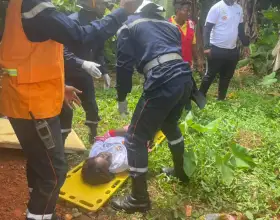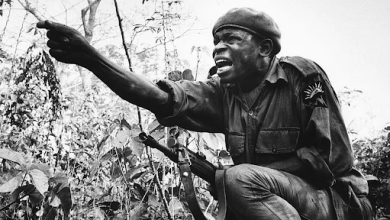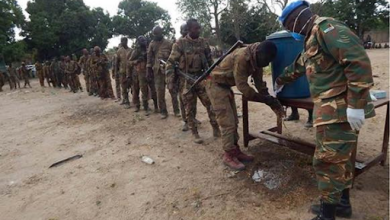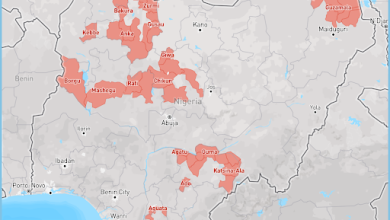Insecurity: What Happened To Kaduna’s N1.2b Aerial Monitoring System?
The Kaduna State Government, Northwest Nigeria, commissioned an Aerial and Surveillance Monitoring System on March 7, 2019, a technology designed to enable security agencies to detect terror attacks and other crimes before they take place across the state. But there is no evidence that it is functioning almost three years after.
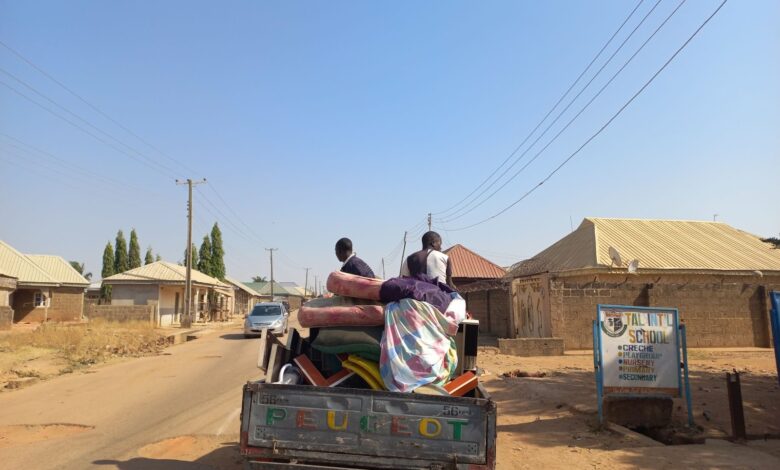
On March 7, 2019, Nigerian President Muhammadu Buhari was in Kaduna State, Northwest Nigeria, to commission the Command and Control Centre of the state’s aerial surveillance and monitoring system worth N1.24 billion.
The system was said to include an Emergency Situation Notification System, designed to enable residents to report security incidents to a toll-free number, after which drones can be deployed for appropriate monitoring.
At the time, the Kaduna State Government said that it was awaiting approval from the Nigerian Communications Commission (NCC) to “deploy 911 as the emergency number.”
HumAngle contacted the NCC through its official phone number made available on its website without a response, but a source who craved anonymity said the Commission only has “an emergency toll-free number which can be used anywhere in Nigeria.”
At the occasion, President Buhari commended “the decision of the state government to commit a significant part of its resources to include technology in the security architecture of the country.”
He pointed out that the surveillance system included “a combination of fixed-wing drones and higher resolution cameras that are put in several locations across the state.”
The president advised the management of the system to work together with the Federal Airport Authority of Nigeria (FAAN) and the Ministry of Defence to safeguard civilians as well as military air traffic.
Apprehending suspects
Joachim MacEbong, Senior Analyst at SBM Intelligence explained that in a place such as the Kaduna metropolis, using an aerial surveillance system, security agencies are likely to find it easier to identify pockets of unrest that would enable rapid response from a team such as the police.
“So, typically, what you have is, they divide the coverage areas into sectors, and people are watching those sectors at all times. If there’s unrest in a particular sector, they direct police resources there to deal with it,” MacEbong said. “You will work with swift level cameras that are also connected to a database of residents with their photographs and so on.”
The security analyst pointed out that this gives security forces the capacity to bring suspects in for questioning. This is because “from a higher level, you can identify pockets of unrest and then from the street level cameras, you can then identify people causing unrest.”
He added that although he is unaware of the status of such a project, it would most likely “be housed with the person in charge of internal security.”
HumAngle had made concerted efforts to get a response from Samuel Aruwan, the Commissioner for Kaduna State Ministry of Internal Security and Home Affairs through phone calls and messages. The last communication involved Aruwan’s senior assistant asking for questions to be sent by the commissioner’s request. But there was still no official response as of the time this report was filed.
The same scenario played out when this reporter contacted ASP Mohammed Jalige, the Kaduna State Police Public Relations Officer (PPRO). He gave a phone appointment but could not be reached at the scheduled time even after a text message was sent.
How the surveillance system works
In his welcoming address, Nasir El-Rufai, Governor of Kaduna State said he believes that technology can enhance the hard work of the security agencies. “Therefore, we decided after careful assessment to invest in modern technology. We have procured Unmanned Aerial Vehicles (UAV) to monitor every inch of the state and relay real-time information,” El-Rufai explained.
“This package includes fixed wing drones and rotary drones, supported by cameras tethered in several locations across the state. The drones have night-time capacity and they are equipped with thermal cameras.”
MacEbong pointed out that N1.24 billion for such a technology is understandable due to the extent of good it can do in checkmating insecurity.
“Apart from the fact that you have to buy the drones themselves, typically, they are drones with longer flight time, having wider coverage due to their respective cameras, and also greater clarity of set cameras.”
Then there is the case that those responsible for monitoring, including trainees who would man the drones and watch the various sectors round the clock have to be paid.
He added that “I don’t know the precise budgetary allocation, but I know Kaduna being one of the states that tries to make such information available to the public should have those particular items brought out in their 2019, 2020, 2021 and even 2022 budget.”
At the signing ceremony of the 2022 budget into law, Governor El-Rufai said “the N278.58 billion budget will be faithfully implemented to advance public welfare and develop human capital and infrastructure.” Data available online showed that the Ministry of Internal Security and Home Affairs got an approved appropriation of N1.4 billion.
Again, in 2020 the Ministry of Internal Security and Home Affairs got an approved appropriation of N2.3 billion.
During the signing of the 2019 budget of N157,449billion, El-Rufai pointed out that it reflects “our commitment to human capital development.” The education and health sectors took up N39.14billion or 41 per cent of the N94 billion capital budget. He described it as “a concrete demonstration of our desire to promote equality of opportunity by putting people first.”
HumAngle was unable to locate a database showing the annual budget for 2019, the year the aerial surveillance and monitoring system was commissioned by the state government.
Toll-free line for residents
MacEbong explained that irrespective of residents across Kaduna State having the ability to call a toll-free line that would prompt security agencies into action, some areas should be permanently under surveillance.
“So if there’s something specific people are calling attention to, and then somehow it was missed, you (security personnel) can then focus on that particular area,” he said. “But having the areas under surveillance all the time would mean that you are able to identify potential unrest before it happens.”
This means that security forces can be proactive and identify suspicious movement from the air. In this way, suspects on the ground can be identified and questioned.
“Of course the calls from residents are important, but I think that should work hand in hand with a 24/7 surveillance from the air.”
“Needless to say, there should be a level of coordination. The NCAA (Nigerian Civil Aviation Authority) for example, should have in its active maps a clear picture of all the objects in the Nigerian air space at any point in time. I don’t see that it should be an issue.”
Drones, unlike other flying aircraft, do not fly at about 30,000 feet and so would not come in direct conflict with commercial or military aircraft. “This means there’s no immediate conflict in that area,” MacEbong added.
El-Rufai, while thanking the president for agreeing to perform the commissioning of the system, said the state government was counting on his support in securing the final approvals from the Nigerian Air Force and the Nigerian Civil Aviation Authority for its full deployment.
Spate of attacks increased despite Aerial Monitoring System
The level of terror attacks in Kaduna State shows that the Nigerian military, particularly its army and airforce are having a hard time in completely dislodging terrorists from the state.
In Dec. 2021, terror groups launched simultaneous attacks in Sabon Tasha, Chikun Local Government Area (LGA) of the state. While security forces attempted to foil an attack in Sabo GRA, another group kidnapped a woman and her children at Oil Village within the area.
Another incident where captives were held within the same LGA and relocated from one camp to the other due to airstrikes revealed the vacuum in the area of air and ground coordination on the part of security forces, a situation that a surveillance system might have made easier.
Currently, Kaduna State is one of the worst hit parts of Northern Nigeria as regards the activities of terrorists, locally called bandits. Killings and kidnappings of its citizens appear to persist despite the efforts of security agencies to nip it in the bud. A recent development involved a bomb explosion that indicates growing terrorism threat.
Support Our Journalism
There are millions of ordinary people affected by conflict in Africa whose stories are missing in the mainstream media. HumAngle is determined to tell those challenging and under-reported stories, hoping that the people impacted by these conflicts will find the safety and security they deserve.
To ensure that we continue to provide public service coverage, we have a small favour to ask you. We want you to be part of our journalistic endeavour by contributing a token to us.
Your donation will further promote a robust, free, and independent media.
Donate HereStay Closer To The Stories That Matter

